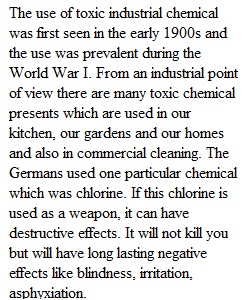


Q Throughout the history of global and civil wars military forces have relied on various forms of chemicals to enhance the probability of successfully defeating the enemy, even at the risk of incurring casualty and deaths within allied forces. Name one toxic industrial chemical that has been employed during wartime efforts and describe the impact of that chemical, as well as the resulting Chemical Weapon Conventions that have been imposed to regulate the future use of such chemicals.
Q According to your textbook, ammonia is one primary ingredient included in fertilizers for agricultural products throughout the United States as well as globally. Various fertilizers may be mixed with other chemicals to create a high explosive such as the one used against the Oklahoma Federal Building. How are those chemicals used to create a weapons of mass destruction, and how is access controlled by the federal government to diminish the probability of such attacks in the future?What is white phosphorous, and what are the commercial applications of this chemical? Why is this a typical weapon used in military operations? What are the effects of the chemical on the human body? Is white phosphorous still an effective weapon today?
View Related Questions